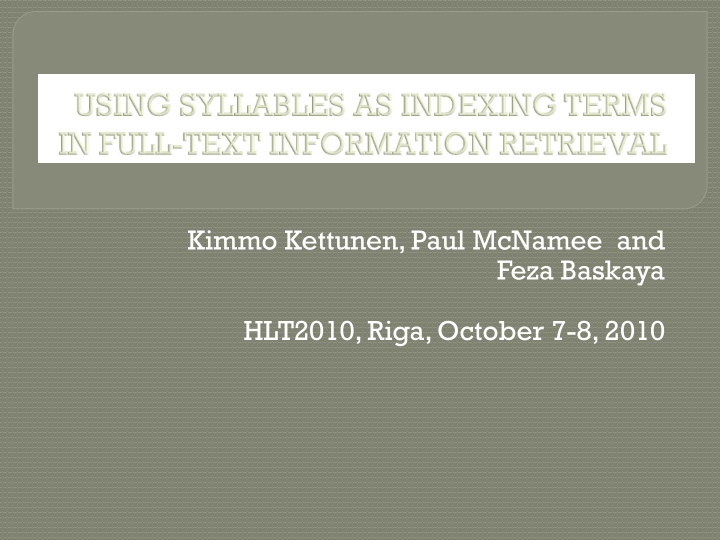



Kimmo Kettunen, Paul McNamee and Feza Baskaya HLT2010, Riga, October 7-8, 2010
1. Why use syllables? 2. Our view of syllabification 3. IR test collections 4. Results 5. Discussion & conclusions
N-gramming has been found very effective in handling of different languages in IR (e.g. P. McNamee and J. Mayfield, Character n- gram tokenization for European language text retrieval, Information Retrieval 7 (2004), 73 – 97.) N = 2-6 chars Syllables resemble n-grams, but there are less of them and their length varies Syllables have been used much in speech retrieval but not much in text retrieval There are syllabifiers around, and it is also quite simple to write a simplified syllabifier for a language Perhaps one simplified syllabifier works for different languages even?
Syllabification as a linguistic problem is trickier than thought, because views of syllable structure vary; thus there might be different syllabifications for words in different languages Algorithmic syllabification can be rule-based or data-driven; nowadays data-driven methods are popular and seem also to be efficient. Typical accurary rates for syllabification are over 95 %, best over 99 % N. B. there does not seem to be gold standard collections for syllabification of different languages, so evaluation of syllabification algorithms is not on the same level as e.g. evaluation of morphological processing
Most of the languages have one basic syllable structure: CV , consonant + vowel We had two basic syllabification strategies: • 1) put a hyphen after every CV • 2) put a hyphen before every CV CV_1 ( ca + rbo + hy + dra + te + s; do + gs; go + es) CV_2 (car+bo+hyd+ra+tes; dogs; goes) These two procedures were tried with 14 languages With 3 languages we tried also proper syllabification programs
Cross-language Evaluation Forum (CLEF) data for 13 languages ( BG, CS, DE , EN, ES, FI, FR, HU, IT, NL, PT, RU, SV) + Milliyet collection for Turkish The size of the CLEF collections vary from ~17 000 to 450 000 documents. The number of topics for each collection is between 50 and 367; Milliyet has 408 305 documents and 72 topics Title + description queries (= long queries) were run for all the languages Retrieval engines: HAIRCUT for CLEF, Lemur for Milliyet Baseline: plain words; comparable methods: Snowball stemming, 4-gramming
For three languages we had proper syllabification algorithms: De, Fi, Tu Syl1 Syl2 Syl3 De 0.31 0.36 0.33 Fi 0.28 0.44 0.33 Tu 0.21 0.27 0.20
Statistically significant relative gains vs. surface forms in four languages using syllable bigrams with CV_1 procedure: German (+18.5%, relative) Finnish (+34.8%) Hungarian (+60.4%) Swedish (+19.9%). With Turkish the CV_1 procedure with syl2 was performing at the same level as 4-grams, which is interesting. Proper syllabification did not outperform CV_1, but performed relatively well with syllable bigrams
Sizes of indexes, examples
Overall our results show that syllables can be used effectively in management of word form variation for different languages. They are not able to outperform 4-grams, but at best they perform at the same level or slightly better than Snowball stemmer for morphologically complex languages, such as Finnish, German, Hungarian, Swedish and Turkish. This is a good result As with n-grams, there seems to be a an optimal length for items put in the index : bigram syllables. These result on index items of 4-5 characters on average. These items do take care of morphological variation relatively well A simple CV procedure does not suit all the languages: it is not language independent, but at least it is flexible with languages.
One simplified syllable algorithm handled 5 morphologically complex languages well IR wise! It suits also morphologically easier languages, but there is not as much to be gained
Recommend
More recommend